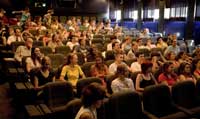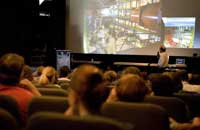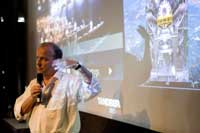ESOF 2006: science close up and personal Inspire article
How do I become a star-chaser? How do we recognise particles that we don’t know? When will fusion power become available to mankind? Sabina Griffith from the European Fusion Development Agreement in Garching, Germany, describes the guided round-the-world trip through the science of the EIROforum…

communicating across the
globe
Image courtesy of Hans
Hermann Heyer, ESO ©
At first, only a few of the audience dared to ask. Then one after the other, they realised that this might be a once-in-a-lifetime chance. How often do you get to talk to an astronomer on his way home after a long night shift under the world’s largest telescope in the Chilean Atacama Desert?
More than 80 students, pupils and teachers from schools in and around Munich, Germany, took the chance and attended the live video conference that linked to six leading European research institutes: CERN in Geneva, Switzerland, ESO in Chile, JET in Culham, UK, and the joint site of EMBL, ILL and ESRF in Grenoble, France. The videolink was part of this year’s European Open Science Forum (ESOF), taking place from 15-19 July 2006 in the Deutsches Museum in Munich. Its intention was to give young people the possibility to interact with representatives of the scientific community and, by doing so, hopefully raise their interest in research and perhaps a scientific career.
Geneva, Switzerland
The round-the-world trip guided by Rolf Landua from CERN started in the Swiss Alps, in Geneva, home of CERN and more than 3000 scientists and engineers from all over the world. One of them is Anne-Sylvie Giolo-Nicollerat, a physicist who is part of a team building the detector for CERN’s new flagship, the Large Hadron Collider (LHC). The LHC is a particle accelerator which will probe into matter deeper than ever before. The first collision is due to start in 2007.

Collider
Image courtesy of Hans
Herman Heyer, ESO ©
Heavy welding and hammering was going on inside the cavern where the detector is currently being built when the young scientist wearing a yellow helmet walked up to the camera and microphone that had been installed for the live videolink. “As you can see,” Anne addressed the audience gathered in the Deutsches Museum, “we have to build very large machines to detect very small particles.”
With the LHC, the scientists at CERN hope to gain new information about the origin of the Universe. And the new detector Anne and her team are constructing will help them to do so. “This machine can take more than one billion pictures per second with one million pixels per picture,” Anne explained. “But how do you detect particles that you don’t know?” a young girl wanted to know. “Thanks to computer models, we know pretty well what to expect,” Anne replied. “Nevertheless the unexpected happens. That’s always thrilling and sends the theoreticians back to their desks.”
But it wasn’t only the scientific aspect of Anne’s work in which the young listeners expressed an interest. When it was their turn to ask questions, they wanted to know why she had chosen to be a physicist, a career in what (in their eyes) is still a man’s world. “I was always interested in books about the Big Bang,” Anne replied. “I guess I just wanted to know how it worked. And yes,” she added, “there are still more men around in this field than women. But that has never been a problem for me.”
Paranal, Chile
From Geneva, the journey continued across the Atlantic Ocean to the Atacama Desert in Chile, where the German astronomer Daniel Kubas was expecting the virtual travellers from Munich. At six o’clock in the morning local time, Kubas had just returned from his night watch scanning the Universe with ESO’s impressive machine, the Very Large Telescope. Though obviously tired, he still had enough energy to explain all the questions about Einstein Rings, gravitational lenses and the capacity of the ESO telescope. Its resolution is comparable with the Hubble Space Telescope, Kubas said – and gave the young listeners a stunning example of what that means. “If there was a car driving on the Moon, we would be able to distinguish the two front lights.” But if they could do so, had they found any evidence that Americans had ever set foot on the Moon, a young listener wanted to know? Not yet, it seems.
Culham, UK
At 12.25 GMT the satellite link switched back to Europe to connect the audience with Marco de Baar and Sandra Grünhagen at the Joint European Torus (JET) in Culham, UK. Sitting in the heart of ‘Ground Control’, the two physicists explained the principles and aims of fusion in general and in detail.

Image courtesy of Hans
Hermann Heyer, ESO ©
“When will the technique that will be tested in the ITER project, the next step in the development of fusion energy, be ready for commercial use?” the audience wanted to know. The answer? If ITER is a success, the first commercial fusion power plants are expected in some 40 years.
“What is work like at an international place like JET?” The response: “Thrilling”. This big project involves not only many different nationalities, but also different cultures.
Finally, “Is there a chance for engineers to participate?” ITER is a large, complex device, which will be used by physicists, but is largely being developed and built by engineers. So there are lots of possibilities!
Grenoble, France
The final stop on the round-the-world trip was Grenoble, home to the European Synchrotron Radiation Facility (ESRF), the European Molecular Biology Laboratory (EMBL) and the Institut Laue-Langevin (ILL). Although the laboratories use different methods, neutron-beam or X-ray, some of their work overlaps: investigating the structures of molecules and proteins. The results of their research deliver important information for the development of drug treatments as well as new materials. “Sometimes we test very old ones too,” Christoph Müller explained, live from his lab at EMBL. “For example, we are currently investigating what gives wood its excellent mechanical properties.”
One and a half hours after takeoff in Geneva, the trip to the frontiers of science returned to the cinema theatre in Munich. A trip that might be just the beginning of a promising journey of investigation for some of the audience.
Resources
- EIROforum is a partnership of Europe’s seven largest intergovernmental research organisations. In EIROforum, these organisations pursue joint initiatives, combine resources, and share best practices. Not only does EIROforum publish Science in School, it also organises Science on Stage, an international science teaching festival that brings together around 500 science educators from 29 European countries to show how fascinating and entertaining science can be. For more information about EIROforum and its initiatives, see here.
- The European Science Open Forum (ESOF) aims to bring together all groups involved in the scientific endeavour, including researchers, policy-makers, representatives of industrial research and development, science journalists and the general public. It is organised by Euroscience, an organisation of research professionals, science administrators, policy-makers, teachers, PhD students, post-doctoral researchers, engineers, industrialists, and any citizen interested in science and technology and its links with society. For more information about ESOF 2006, see here.
- For more information about Euroscience, see here.
Institutions






